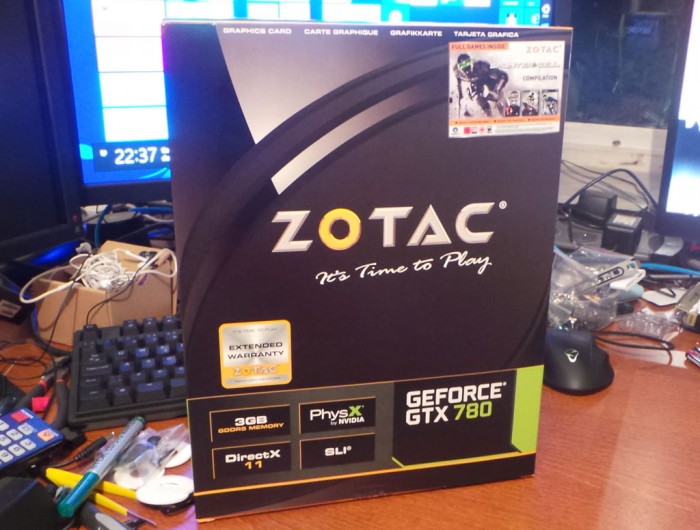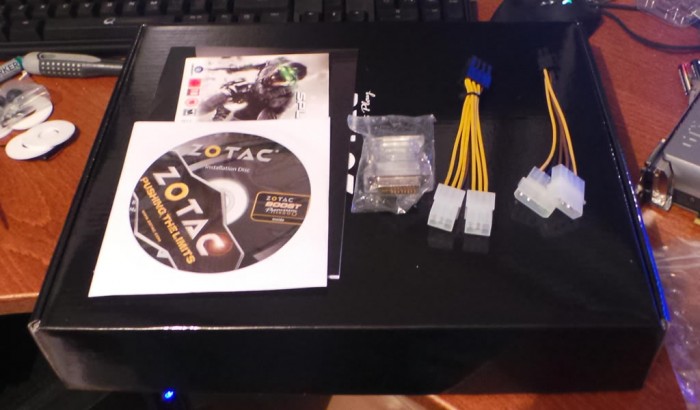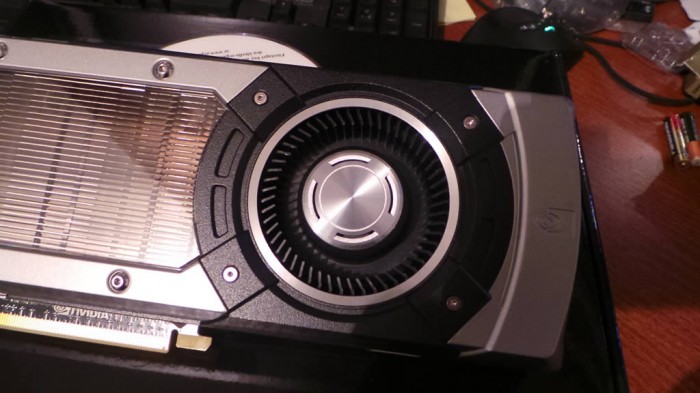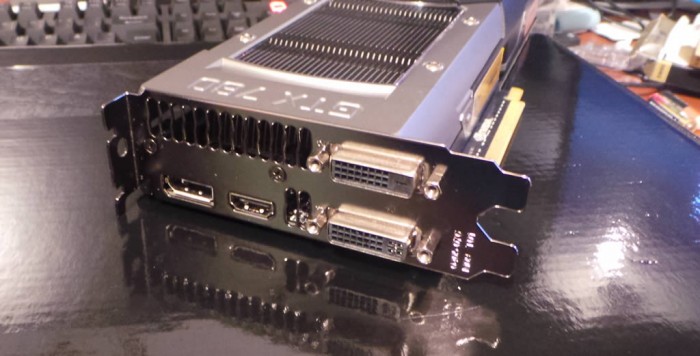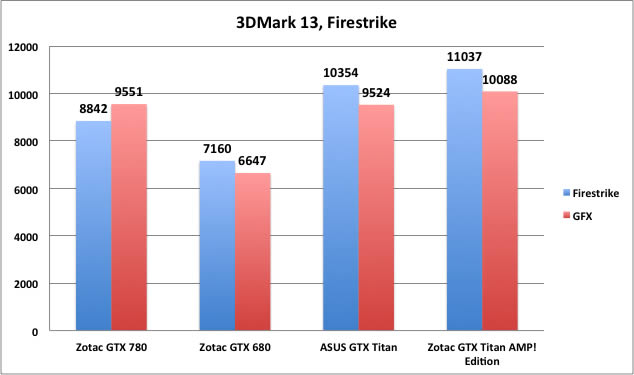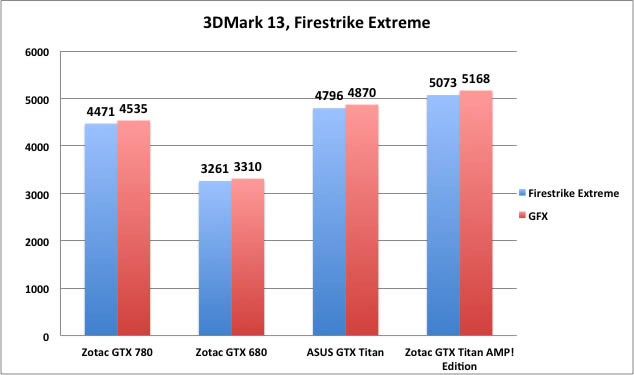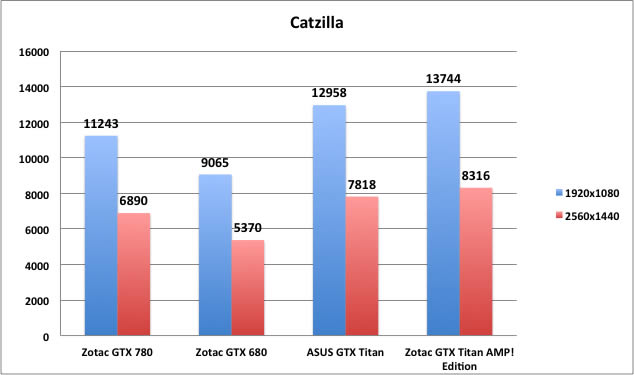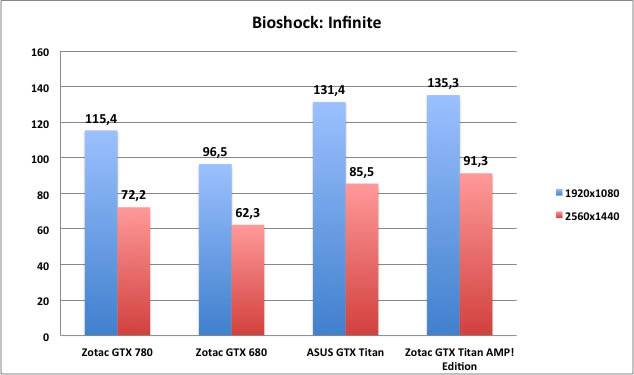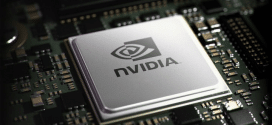Hot on the heels of the GTX Titan comes the new GTX780 that uses the same type of GPU as we see in the GTX Titan. Zotac of course is one of the companies coming out with their own GTX780 card and we have taken it for a spin to see how it fares compared to the GTX 680 as well as the Zotac GTX Titan AMP! Edition that we tested earlier this month.
SPECIFICATIONS
| GTX 690 | GTX TITAN | GTX 680 | GTX 780 | |
| Stream Processors | 1536 x 2 | 2688 |
1536 |
2304 |
| Texture Units | 128 x 2 | 224 | 128 | 192 |
| ROP’s | 32 x 2 |
48 |
32 | 48 |
| Base Core Clock | 915MHz | 837MHz | 1006MHz | 863MHz |
| Boost Clock | 1019MHz | 876MHz | 1058MHz | 900MHz |
| Memory Clock | 6008MHz | 6008MHz | 6008MHz | 6008MHz |
| Memory Interface | 256-bit x 2 | 384-bit | 256-bit | 384-Bit |
| Memory Qty | 2GB x 2 | 6GB | 2GB | 3GB |
| TDP | 300W | 250W | 195W | 250W |
| Transistors | 3.5B x 2 | 7.1B | 3.5B | 7.1B |
| Manufacturing process | 28nm | 28nm | 28nm | 28nm |
| Price | $999 | $999 | $499 | $649 |
The GTX 780 uses the same architecture that we see in the GTX Titan including the Kepler GK110 GPU. While the Titan still has a bit better specifications the GTX 780 is a big step up from the GTX 680.
We have posted an article about the features of the GTX 780 which you can read here. Anyone who has been interested in the GTX Titan knows what you can expect.
CLOSER LOOK
The Zotac GTX780 comes in the same style of box as all their other cards. It is well packaged and should not be damaged in transit. As the box shows Zotac includes three games with the card. Some previous cards including the Zotac GTX Titan AMP! We reviewed a while ago comes with 3 Assassins Creed games but this time Zotac has chosen 3 Splinter Cell games instead.
In addition to the games we get a CD with drivers and Zotacs own Firestorm overclocking utility. We also get power-adapters and a DVI to VGA-adapter.
The Zotac GTX780 uses the reference design and looks exactly like the GTX Titan. In fact, as you can see from the image it is easy to mistake them from each other if you do not look closely.
The fan in the GTX 780 is the same as on the GTX Titan and it works very well in keeping the card cool while not making a lot of noise.
We get two DIV, one HDMI and one full sized DisplayPort-connector on the card.
Testing Methodology
The OS we use is Windows 8 Pro 64bit with all patches and updates applied. We also use the latest drivers available for the motherboard and any devices attached to the computer. We do not disable background tasks or tweak the OS or system in any way. We turn off drive indexing and daily defragging. We also turn off Prefetch and Superfetch. This is not an attempt to produce bigger benchmark numbers. Drive indexing and defragging can interfere with testing and produce confusing numbers. If a test were to be run while a drive was being indexed or defragged, and then the same test was later run when these processes were off, the two results would be contradictory and erroneous. As we cannot control when defragging and indexing occur precisely enough to guarantee that they won’t interfere with testing, we opt to disable the features entirely.
Prefetch tries to predict what users will load the next time they boot the machine by caching the relevant files and storing them for later use. We want to learn how the program runs without any of the files being cached, and we disable it so that each test run we do not have to clear pre-fetch to get accurate numbers. Lastly we disable Superfetch. Superfetch loads often-used programs into the memory. It is one of the reasons that Windows Vista occupies so much memory. Vista fills the memory in an attempt to predict what users will load. Having one test run with files cached, and another test run with the files un-cached would result in inaccurate numbers. Again, since we can’t control its timings so precisely, it we turn it off. Because these four features can potentially interfere with benchmarking, and and are out of our control, we disable them. We do not disable anything else.
We ran each test a total of 3 times, and reported the average score from all three scores. Benchmark screenshots are of the median result. Anomalous results were discounted and the benchmarks were rerun.
Test Rig
| Test Rig | |
| Case | Thermaltake Level 10 |
| CPUs | Intel Core i7-3930 @3.2 Ghz |
| Motherboards | ASUS P79X Deluxe |
| Ram | 32 GB |
| CPU Cooler | Corsair H100 |
| GPU |
Zotac GeForce GTX 780 Asus GeForce GTX Titan Zotac GeForce GTX Titan AMP! Zotac GeForce GTX 680 |
| GeForce Drivers |
320.14 (GTX 680, 690 and TITAN) 320.18 (GTX 780) |
Synthetic Benchmarks & Games
We will use the following applications to benchmark the performance of the Zotac GeForce GTX 780 video card.
Synthetic Benchmarks & Games
| Benchmarks |
|---|
| 3DMark11 |
| 3DMark Firestrike & Firestrike Extreme |
| Unigine Heaven Benchmark 4.0 |
| Unigine Valley benchmark |
| Catzilla Benchmark |
| Crysis 3 |
| Bioshock Infinite |
3DMark 11
In 3Dmark11 the new Zotac GTX780 beats the “old” GTX680 with almost 35% higher scores. It is just 10% behind the regular GTX Titan.
3DMark 2013 – Firestrike
In the regular test we again see the GTX780 beat the GTX680 with over 30% better scores. It trails the GTX Titan with about 7% lower scores.
As we turn up the settings to the Extreme setting the difference between the GTX680 and the GTX780 increases to almost 40%. The difference between the GTX780 and the regular GTX Titan stays around 7%.
Unigine Heaven 4.0 and Valley
Setting: 8xAA, Ultra
Next up is the Unigine Heaven benchmark. The difference between the GTX680 and the GTX780 is between 39% and 44%. That is some serious improvements compared to a card just 1 year old. The gap up to the GTX Titan is just under 10%.
Setting: 8xAA, Ultra
Also in the new Unigine Valley-benchmark we get a similar results with the GTX780 beating the GTX680 with around 35-40% better scores while trailing the GTX Titan around 10%.
Catzilla
This is a new benchmark that looks nice and is quite fun to watch. You can find it at http://www.allbenchmark.com/.
In this benchmark the difference between the GTX680 and the GTX 780 is around 25% while the GTX Titan is around 10-13% faster than the GTX 780.
Crysis 3
We used Fraps to record the framerate while running through the ship in the beginning of the game fighting a few guys, blowing up a crate and some other action.
Setting: 8xAA, 16xAF, Very High Texture resolution, Very High all other settings
It would not be a Crysis-game if it did not tax the system a lot. As evident from the scores neither card really is playable at these settings and we would need to turn off/down a few settings to use it in the game. Still, the GTX780 can produce 25% better frames per second at 1920×1080 than the GTX 680. When we increase the resolution the difference soars up towards 65% but neither card really gives us framerates worth talking about. The difference between the GTX 780 and the regular GTX Titan is no more than 2-3% so if you plan on playing Crysis 3 you really will not win much by getting a regular GTX Titan.
Bioshock Infinite
Setting: Using Adrenaline Benchmark Tool: Ultra, 16xAF
Even though this is a new game it does not really tax the system that much. The difference between the GTX680 and GTX780 is around 15-25% while the regular GTX Titan beats the GTX780 with just over 10% better framerate.
Overclocking
Overclocking the GTX 780 is a bit weird. Since the card already is overclocking itself dynamically via NVIDIA Boost 2 you never are sure what you will end up with when setting a target clock in MSI Afterburner or Zotac Firestorm. For example we set the card for a target clock of 1050 MHz but when we ran the benchmarks we ended up with a max clock of around 1176 MHz instead. To achieve this overclock we also increased the target temperature to around 85C and allowed the card to use 105% if the power draw.
The best overclock we achieved in our limited time with the card was 1050 MHz for the core (up from 863 MHz) and 6400 MHz for the memory (up from 6008 MHz). This resulted in between 10-20% better results in 3DMark Firestorm Extreme and Bioshock Infinite.
Summary
It is not hard to be impressed with the new Zotac GTX 780-card. It is a huge upgrade over the GTX 680 and, as expected by the hardware, is close to catching up with the GTX Titan. It is a silent card and NVIDIA:s various features like Boost 2.0 really enhances the function of the card.
What does it cost then? We have not found the Zotac GTX 780 on sale yet in the US but other GTX 780-cards retail for around 650$-680$ so expect it to cost around that. This is about 35% less than a $999 GTX Titan and you still get around 85-95% of the performance of the GTX Titan making the Zotac GTX 780 a great buy. The Titan though has 6 GB of memory which makes it a bit more futureproof for those who also want to do multi-monitor-gaming.
| OUR VERDICT: Zotac GTX 780 | ||||||||||||||||||
|
||||||||||||||||||
| Summary: We love it! NVIDIA again delivers a video card that pumps out performance and still does not sound like a jet engine. Zotac has not really done anything special with it but why should they? The results speak for themselves. The card receives The Bjorn3D Golden Bear Award and the Bjorn3D Seal of Approval. |
 Bjorn3D.com Bjorn3d.com – Satisfying Your Daily Tech Cravings Since 1996
Bjorn3D.com Bjorn3d.com – Satisfying Your Daily Tech Cravings Since 1996

